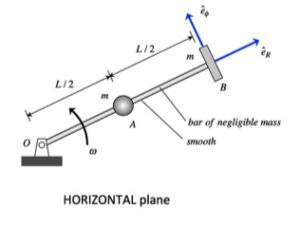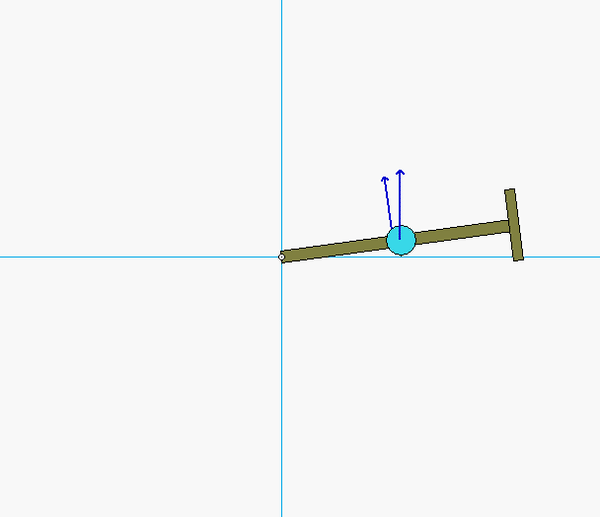| Problem statement Solution video |
DISCUSSION THREAD

Any questions?? Please ask/answer questions regarding this homework problem through the "Leave a Comment" link above.

You are asked to investigate the dynamics of this system during the time from release through to the time of immediately after when A strikes B.
- Divide this time of investigation into two segments: 1 to 2, and 2 to 3.
- From times 1 to 2, A slides outward on the arm until it almost impacts B. During this time, angular momentum of A+B+arm is conserved, as well energy for that same system is conserved.
- From times 2 to 3, A impacts B. During this time, angular momentum of A+B+arm is conserved; however, due to the impact, energy is NOT conserved. Instead, we will use the coefficient of restitution relating the change in radial velocity for A as the second equation.
HINTS:
STEP 1 - FBD: Draw a SINGLE free body diagram (FBD) of the system of A+B+arm.
STEP 2 - Kinetics: The only force that you will see acting on this system during the full range of time from 1 to 3 is the support force at O. Because this forces acting through point O, angular momentum about O is conserved throughout. During the pre-impact time of 1 to 2, also write down a conservation of energy equation. During the impact time of 2 to 3, write down the COR equation involving only the radial components of velocity for A.
STEP 3 - Kinematics: At Instant 1, A and B have only eθ components of velocity. For Instants 2 and 3, A has both er and eθ components of velocity, and B has only eθ components of velocity.
STEP 4 - Solve.
Do we need to find the height at which the ball moves for the energy equation? If so, how would we calculate that without the angle of the bar when the ball makes contact?
This situation occurs in the horizontal plane, so there is no change in height and gravity does no work.
If that is the case, then wouldn't the energy in the system be zero since the ball is released from rest and there is no force capable of doing work on the system? That would mean that the velocity right before impact would be zero.
The particle is released from rest RELATIVE to the arm. The point on the arm under the particle has a speed of (L/2)*omega_1 and with the velocity being perpendicular to the arm when A is released. Therefore, A is not a rest on release. You can see this in the animation.
Since it is on the horizontal plane, gravity is not affecting this problem, and because of that U12 is 0
Since the arm and particles are in the xy plane, does that mean potential (as used in the energy equation) is zero throughout the entire time?
Yes, that implies that the gravitational potential does not change as the system moves in the xy-plane.
Since the impact of A hitting B between times 2 and 3 affects only the velocity of A in the e^r direction, can we say that the velocity of A in the e^theta direction is the same at times 2 and 3?
As recommended above, we should use conservation of angular momentum between times 2 and 3. This conservation of angular momentum will result in the angular momentum being unchanged during that time period. From H_O3 = H_O2 we see that omega_3 = omega_2.
In short, the answer to your question is YES.
In the hints, there's a mention of a "COR" equation, could someone remind me what that is referring to?
COR = coefficient of restitution
At the initial position, does body A have velocity only in the theta direction?
Oh i see this was answered in step 3 of the hints
Do note that Omega 1 is not the same as Omega 2 and you might need to use Conservation of angular momentum in order to calculate the relationship between them
Are there any non-conservative forces to account for in this problem?
In 2 and 3 is total momentum a combination between angular and linear momentum.
You should NOT combine the linear and angular momentum terms. Between times 2 and 3, angular momentum is conserved; however, linear momentum is NOT conserved.
I believe if you can look at your FBD you can see that there are no extra forces in the system, so the equation would simplify to only kinetic energy involved, as we are also on a horizontal plane.
It's important to remember that, when using the coefficient of restitution, you only analyze the impact in terms of the speeds in the normal direction. In this case, the normal and radial directions are equivalent. Thus, only radial speeds of A and B, or the component of velocity in the r_hat direction, are needed to analyze the collision. The collision will not impact values in the theta_hat direction.
I found it easiest to look at this problem in three phases: released from rest relative to arm, right before collision, and after collision. Therefore, we can use the angular momentum conservation, work-energy, and COR equations for each of these phases and solve for the velocity of A at each phase.
Considering that 1 is the moment of release and vAR1=0, then by energy conservation would vAR2=0 as well?
Never mind. After reading the hints again, this isn't true.
No, that would not be true. The speed of A (which includes both radial and transverse components of velocity) will remain unchanged due to conservation of energy. However, each component will change (the transverse component is reduced, as seen by conservation of angular momentum, and the radial component will therefore increase).
It is important to understand from 2 to 3, there is only e_r velocities are considered when calculating the COR, where we can assume velocities Vb to be stationary depending on the frame of reference.
Just a minor clarification. It is best to say only that the radial component of the velocity of B is zero, rather than to say the B is stationary.